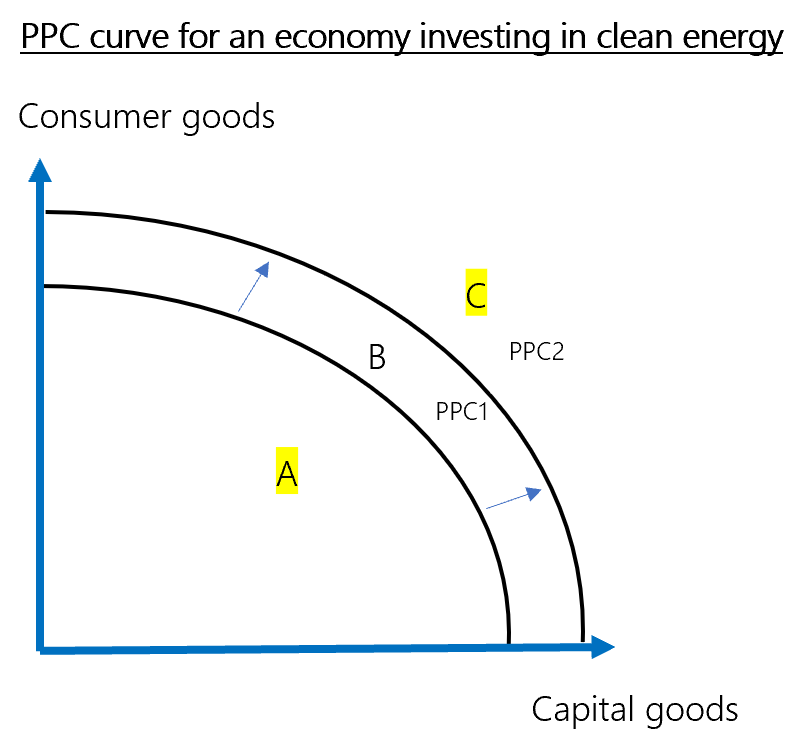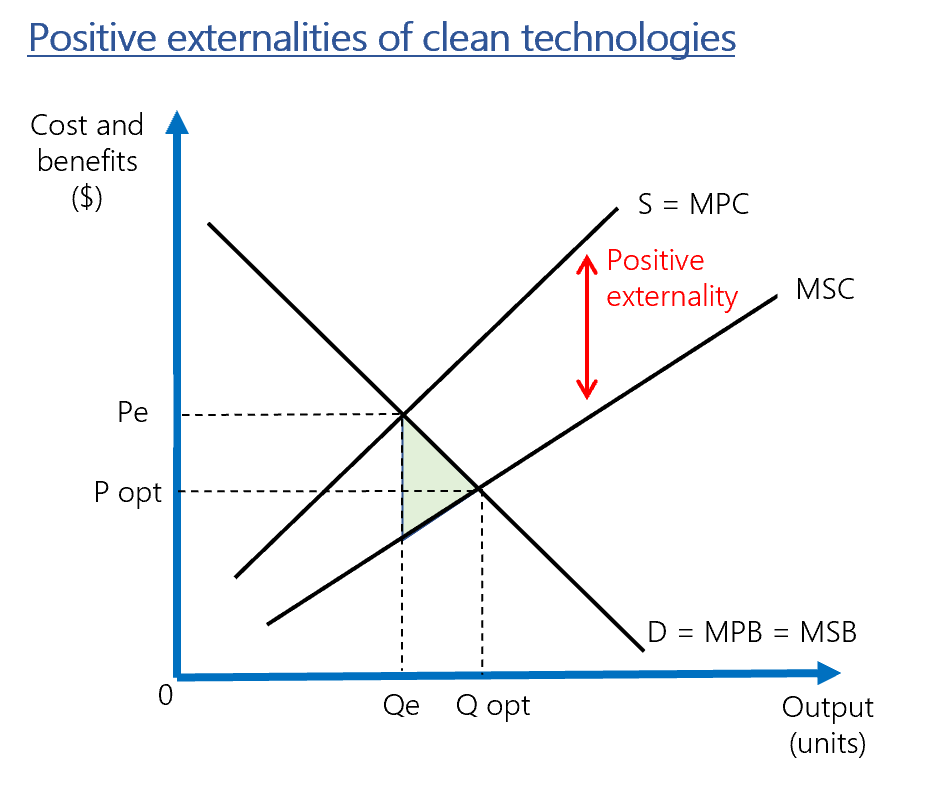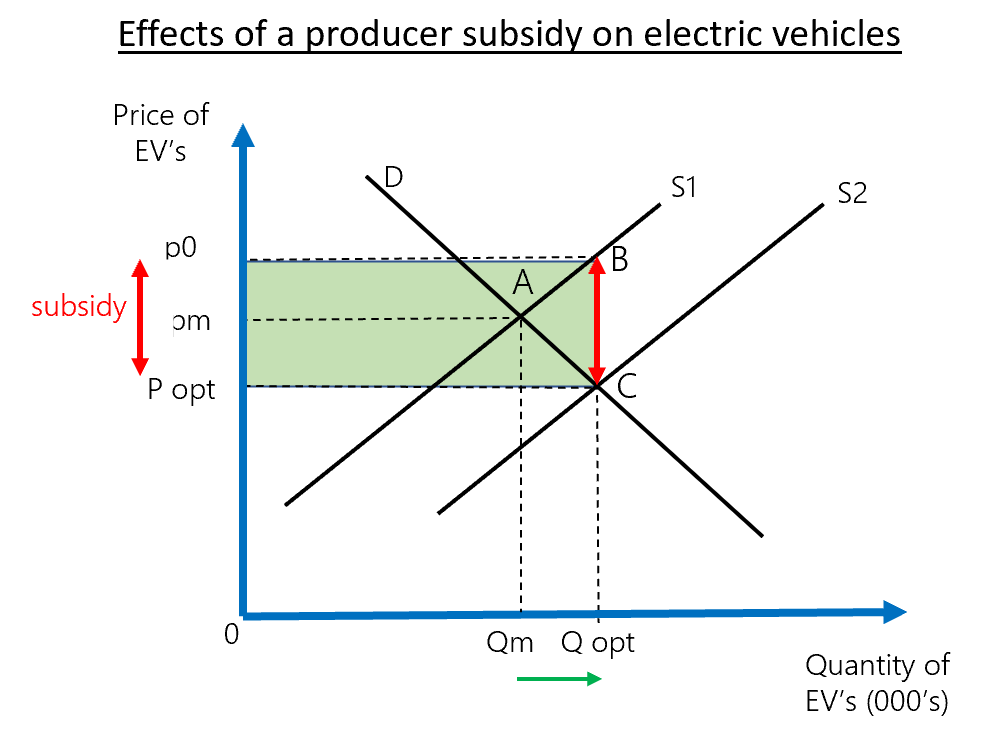IB Microeconomics
Real World Examples (RWE's) Subsidies
Discuss the view that a subsidy is the best way to encourage increased use of clean technologies [15]
A subsidy is a financial aid offered by the government to reduce the cost of producing or purchasing certain goods, in this case, clean technologies, specifically with a view to encouraging the amount or quantity supplied to the market.
The importance of clean technologies may help to reduce the use of polluting (less clean technologies or more energy intensive technologies) which create market failure. But also, cleaner technologies may preserve or offset the use of finite resources, which may not be available for future generations! Thirdly, cleaner technologies may enable greater creation by enhancing the capital component of a country and potentially enhancing the productive capacity of an economy, which can be seen in Diagram 1. An investment in cleaner technologies may support a country’s move towards more sustainable goals and development.
Diagram 1 indicates a Production possibilities frontier curve (PPC) for a nation that benefits from subsidies and manages to achieve actual and potential growth, moving the use of resources from point A to B to C (the last movement represents a shift outward of the PPC curve) which enables the production of more capital and consumer goods.
Additionally, clean technologies tend to incur positive externalities, which means that there is a positive spillover to society, a net social benefit of production. However, given that private costs tend to be high in this case (Pe), output tends to be lower than optimal (Qe). This can be seen in the positive production externality (Diagram 2) where the underproduction is represented by a potential welfare gain, which is not realized (green triangle).
Subsidies are useful in that, subsidies generally lower the production and purchase cost, making them more affordable and therefore desirable, which can lead to an increase in demand and supply (Diagram 3). The Chinese government illustrates this investment in clean technologies with a raft of subsidies to the car industry. This was essential to allow new manufacturers (such as Li, X-Peng, Nio, Link and many others) to invest in research and development and to overcome high costs of launching a company and to lower otherwise, initially very high per unit car costs. China is a world leader in electric vehicles and take up and demand for cars is very high compared to less well subsidized countries, like Germany whose subsidies have dried up as of 2023 due to budget deficits!
This sudden unplanned withdrawal of subsidies could be seen to be a huge failure as it represents considerable sunk costs which may not have produced the desired result because of their premature cessation! In this case, one could argue that the opportunity cost was extremely high and represented poor value to other stakeholders!
The subsidies granted by the Chinese government seek to increase output by reducing the marginal private cost (Diagram 2) toward marginal social cost. Given these points, the Chinese governments intervention into the market has met a number of the explicit goals of subsidies.
However, the question is, ‘at what cost’?
Subsidies are expensive and ultimately have to be paid (indirectly) by the taxpayer. There remains a question over the affordability and whether the taxpayer more widely, should have to shoulder the burden of electric vehicles that still remain significantly above the market price of petrol cars! This represents a serious disincentive to consumers with lower incomes and savings. There is also a strong case for the opportunity cost being too high, which can be demonstrated in a less successful example of subsidies, Texas in America has invested heavily for four decades now, “These tax incentives were intended by Congress to support technology that was too expensive in its early development”. This supports the idea of usefulness of subsidies in the early phase of new technology. However, the massive opportunity cost is hinted at, “Through 2018, these subsidies amounted to more than $100 billion. This amount is far in excess of federal assistance received by other electricity sources”. This tax revenue could have been used on the production of other merit goods or other infrastructure and long-term investments! Studies have “concluded that these resources are now cost-competitive with conventional electricity sources” so now seems like the time to discontinue the subsidies to prevent further distortion of the market place for clean energy.
One large criticism is that, subsidies savings for companies have not been passed onto the customer, “subsidies have lowered out-of-pocket costs for renewable project developers but have not led to similar savings for electricity ratepayers”! This may well suggest that subsidies benefit the company, but unless government demand certain outcomes, companies may well refuse or limit the savings passed onto the customer who may display more inelastic demand for cleaner energy because of their desire to be part of an environmental change, rather than maximizing utility through the purchase of the cheapest energy source!
These two real life examples show how market outcomes can be improved (in terms of price and quantity) as per the governments desire. However, the Texas example shows the potential for a growing dependency on the subsidy. It is also not easy to quantify the opportunity cost as there is no side-by-side experiment to show how the investment may have performed if directed into another clean technology! Given this limitation, the attempt to improve market outcomes may have led to further misallocation of resources!
The ultimate conclusion must be that, careful design and implementation as well as monitoring must be part of any program of subsidies.


Diagram 1: PPC curve for an economy investing in clean technology.

Diagram 2: Positive production externalities of investing in clean technologies.

Diagram 3: A producer subsidy granted to electric vehicle manufacturers.



